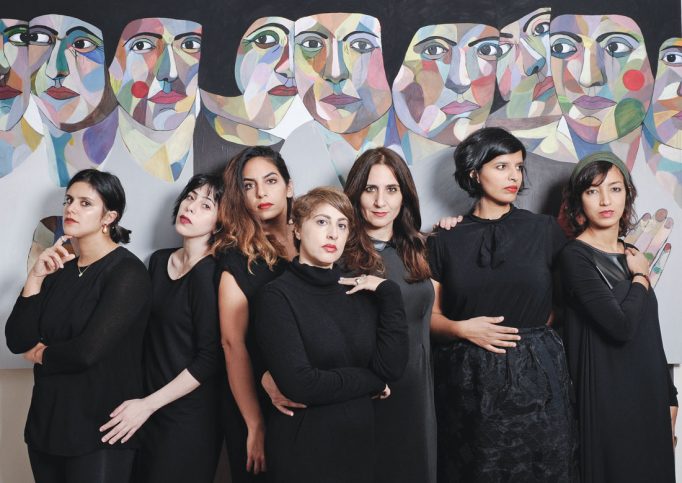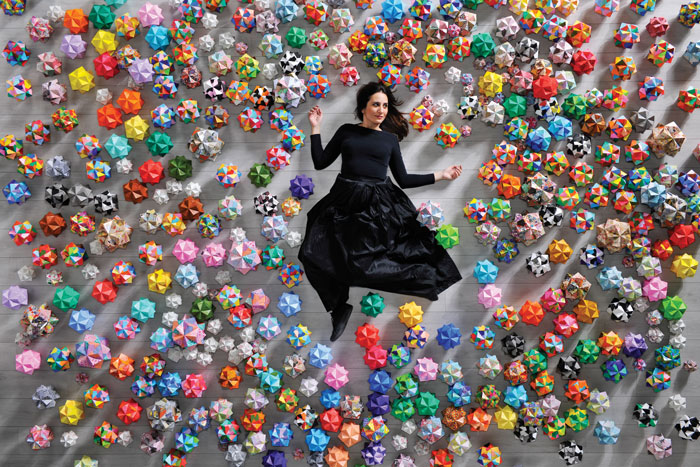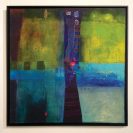By Anna Wallace-Thompson
The faces of Kuwaiti artist Ghadah Alkandari’s Eves are familiar – they fill a universe on canvas, spread their wings across pages of her journals, wave at you as three dimensional puppets. The archetypal character in her oeuvre, Eve has always existed as an extension of Alkandari – a character who is all of us yet none of us; so wholly the artist yet an independent being. Her arched brows, rosebud lips and severe hairstyle identify her instantly; the bright spots of color on her cheeks belie the rambunctious and passionate inner monologue that must exist behind her eyes, at once playful, steely and all-seeing.

Ghadah with Eves real and imagined. The artist often collaborates with other women for her projects, collecting special ‘Eves’ along the way. These are just some of the Eves that hold a special niche in Ghadah’s world: (left to right) Jana Alnaqeeb, Xeina Almusallam, Yasmine Alkandari, Lubna Saif Abbas, Ghadah, Deema Al-Ghunaim and Fatma Abodoma.
Gaining recognition with the 2008–9 series The Yellow Tape Portraits, the character of Eve was born initially out of a painful separation and the ensuing familial vitriol, and has always been Alkandari’s own protagonist, acting out both heartaches and victories, losses and joys. Her new works, however, on display at the solo exhibition Until, at Contemporary Art Platform in Kuwait (11 January – 22 February) mark a departure of sorts.
Building on previous forays into sculptural installations, including a 2014 residency at Mathaf: Arab Museum of Modern Art in Doha, the series which has inspired the exhibition’s title, Until Love, comprises over 400 (and counting) origami paper polyhedra of various sizes and colors. “I started making these polyhedra (let’s call them stars) about two years ago,” explains Alkandari. Parsing emotions at a time of change in her life, she was inspired by Gabriel Garcia Marquez’s 100 Years of Solitude. “This idea of the character of Amaranta embroidering her own shroud got me thinking about the things we do while we’re waiting; in her case, waiting for death, in mine, I suppose I felt I would start creating these stars until I found love – it really was a simple idea like that. I started creating and creating, and then it became an Instagram project, and, as with everything I work on, it snowballed from there.”
As with all her work, she imbues each piece with a part of herself – in some cases, literally, from strands of her hair, to hidden messages, rather like the missives in fortune cookies. “There came a point where this new work stopped being about love, and started becoming about me and my transient living,” explains Alkandari. “I feel like I’m always waiting for something to happen – I’m not ‘there’ yet. I don’t even know where ‘there’ is, so I’m hoping to find out one day.” The experience of Until has also seeped into her painterly practice, gradually changing the color palette with which she depicts Eve. “The colors I chose and their interplay with each other became a fixation for me, to use these colors and deconstruct all the shadows in the faces,” she says. “The paintings grew very much in tandem with the origami structures.” In fact, earlier works created in this series featured the paper stars themselves, such as Comet, in which Eve sits, surrounded by them, with a more ominous mass comprising polyhedra coming at her out of the sky like the titular meteor.
What is also striking about these new paintings is their scale. At 180 x 240 cm, the two largest pieces loom heavy over the viewer, as in Come in/Come Close/Come Together, in which a chorus of women stand huddled together. The rest, at 150 x 230 cm, are no less striking, such as Eve to Eve. All skullcaps and ruffles, like two hauntingly beautiful Pierrots, the two protagonists stare at each other, eye to eye, serious, meaningful, full of knowledge. Or take Eves at the Forum, in which Alkandari is beginning to move into more abstracted geometric shapes; there are still women here, but their bodies fragment into a new direction.
The third and final component of Until is intimate, and features 80 portraits of women. Putting out an open call, she asked women to send in their stories – the emotions they evoked produced these small 30 x 30 canvases, and to enter the room is to be completely enshrouded in faces. Voices speak on endless loop – at times speaking together in cacophony, at times in silence, at others, individual voices discernable like fleeting strands of narrative. This focus on the narrative element has always been at the heart of Alkandari’s work. However, while each painting comes with the artist’s own internal story as she produces it, and while projects, such as Etna and the Baby (2009), have Alkandari talk through a narrative as she draws, rarely have external voices provided the soundtrack.

Bocce Girls, 2016, acrylic on canvas, 180 x 150 cm.
“When you look at these pieces, they’re all the same face, but when you really look at them, they’re all different,” she explains. “I do like to get people involved in my work, I love to have another point of view. I listened to these women’s voices as they sent me their stories and I’m very visceral and emotional – some are naughty; others would make me cry. Then I would paint how they made me feel.” These women, sad as some of their stories are, however, are not beaten or submissive. “My work is very much a celebration of women,” asserts Alkandari, “and I really dislike how women are often portrayed as weaker, particularly in regional art, by painting them behind a veil and so forth. Kuwaiti women in particular are such powerhouses, they are so inspirational”.
Like the polyhedra, these are not a faceless mass – many facets converge and collide as personalities are revealed through the finite details of each face. “I see these women and I see people who are strong,” says Alkandari. “Women seem to play so many roles – the submissive wife, the powerful career woman – why can’t we all just be ourselves? I’m here, painting and creating and trying to be outside of my head and just be me and that’s all we can really do.”
Until is Ghadah Alkanadri’s fifteenth solo exhibition that will showcase at Contemporary Art Platform in Kuwait starting January 11th – February 22nd. CAP is located on the Mezzanine floor of the Life Center in Shuwaikh Industrial, Block 2, Street 28. Please call 2492 5636 for more information or check out @CapKuwait on Instagram for the latest updates.
For Ghadah’s daily musings, check out her blog www.prettygreenbullet.com. Follow the artist on Instagram @PrettyGreenBullet, and if you’re missing the playful ‘Eve’, check out @Stories_of_eves.
Photography by Thilo Mayer.
Photography of Ghadah’s paintings by Tony Santos.











